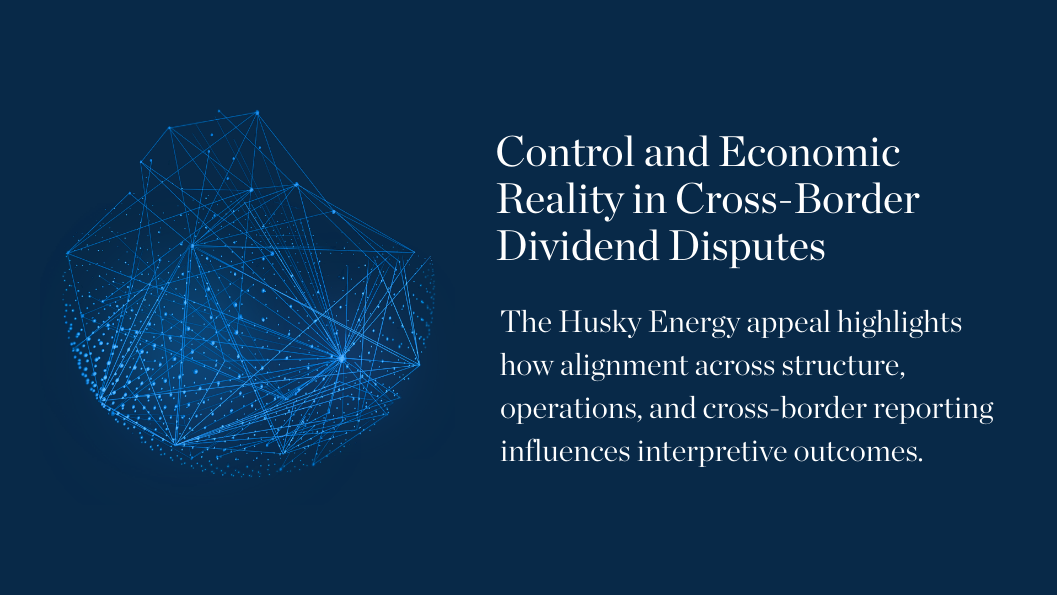
Key Takeaways
- Inconsistent cross-border descriptions created tension between the structure’s design and its economic reality.
- Risk and benefit flowed to different entities across jurisdictions, shaping the withholding outcome.
- By the appeal stage, the decisive factor became how clearly the competing case theories aligned the documented structure with its economic operation and cross-border reporting.
The Situation
Ahead of a special dividend, Husky’s Barbados shareholders transferred a block of Husky shares to related Luxembourg companies under a securities lending agreement. The Luxembourg entities received the dividend, and the structure relied on the 5% Canada–Luxembourg treaty rate. On paper, the arrangement aligned with standard lending mechanics. In practice, the Luxembourg entities were fully hedged, provided no collateral, and passed the dividend value back to Barbados. The Federal Court of Appeal concluded that the Luxembourg companies were not the beneficial owners, and the higher Canadian withholding rate applied.
What Made the Difference
The Court compared the structure’s documented design with its real operation across jurisdictions. Full hedging, the absence of collateral, and the flow-through of dividend value showed where control and benefit rested. Differences in how the arrangement was described in Canada, Luxembourg, and Barbados contributed to a fragmented picture. Once the dispute reached the appeal stage, the interpretation often turned on how clearly the case theory aligned the documented structure with its economic operation and cross-border reporting. The economic pattern carried more weight than the labels in the agreements.
Mechanics vs. Interpretation
Mechanics determine whether a structure meets the formal requirements in legislation and treaties. Interpretation governs how courts evaluate the arrangement when the CRA applies pressure. In cross-border disputes, outcomes often turn on which account — among the competing case theories — most closely aligns structure, operations, and cross-border reporting.
| Provision | Mechanical Requirement | Interpretive Requirement | Relevance in Husky Energy (FCA) |
|---|---|---|---|
| s. 212(2) | Imposes withholding tax on dividends paid or credited to non-residents. | Identify who, in substance, received, controlled, and benefited from the dividend; determine the correct rate based on residence and beneficial ownership. | The FCA focused on who actually controlled and benefited from the dividend. The reduced treaty rate did not apply, and the higher Canadian withholding rate governed. |
| s. 245 (GAAR) | Authorizes reassessment when an avoidance transaction misuses or abuses the Act’s provisions. | Interpreted purposively to assess whether the outcome aligns with the Act’s object, spirit, and purpose. | GAAR framed the interpretive context, highlighting the tension between the structure’s design and its economic reality, even though GAAR did not form the basis of the FCA’s final decision. |
The Signal for Business Leaders
Inconsistencies across documents, operations, and cross-border reporting often expand audit scrutiny and widen the range of potential withholding outcomes. During the dispute, competing case theories shape how the arrangement’s economic reality is understood. The court chooses the case theory that fits the facts and makes the most sense of how the arrangement actually operated, and that most closely reflects control of value.
Case Reference: Husky Energy Inc. v. HMK, 2025 FCA 176

.jpg?width=120&name=Counter%20Tax%20Litigators%20Logo%20Stacked%20(MidnightBlue%20on%20White).jpg)













.png?width=400&height=400&name=CT-How_Can_We_Help-22_july_NewGraphic_b(small).png)

.png?width=1386&height=1224&name=2025%20Legal500%20Elite%20Boutique%20Award%20(Badge).png)
.png?width=1386&height=1224&name=ITR%20Finalist%20Practice%20Leader%20of%20Year%20Peter%20Aprile%202024%20(Badge).png)
.png?width=1386&height=1224&name=2025%20Legal500%20Leading%20Firm%20Client%20Satisfaction%20Award%20(Badge).png)





.png?width=1386&height=1224&name=ITR%20Tax%20Innovator%20Finalist%202024%20Award%20(Badge).png)
